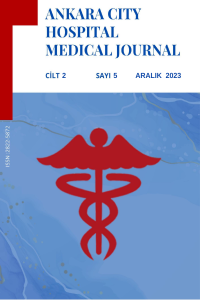Öz
In the last few years, the incidence of telangiectasia and small bleeding complicated with chronic myelomonocytic leukemia (CMML) in patients treated for small bowel bleeding has been increasing, yet to the best of our knowledge, we describe this rare case of telangiectasia and small bowel bleeding with CMML.
Telangiectasia, also known as spider veins, is a disorder causing abnormal capillary diameter dilation, microvascular wall fragility, and increased blood drainage.1 It has a low incidence but a high case fatality rate. Small bowel bleeding due to capillary dilation is a threatening condition with a high case fatality rate. Chronic mononucleosis (CMML) is a rare, variable disease primarily seen in elderly patients, characterized by leukemic dysplasia, hematopoiesis, and monocyte proliferation, with an average survival time of 12–18 months.
Case 1: A 76-year-old male experienced intermittent melena for 15 days, which worsened for 2 days. After a polypectomy, he complained of black stool for 2 days, followed by dizziness, fatigue, palpitation, and discomfort. He underwent blood transfusions, hemostasis, and other treatments. A colonoscopy revealed multiple ulcers in the small intestine and mucosal bulges[Fig1]. Intraoperative surgical exploration revealed fine capillaries in the ileal intestinal wall. Partial ileal resection was performed, and the patient’s white blood cells increased to 37 x 109/L, hemoglobin increased to 82 x 109/L, and platelets decreased to 99 x 109/L. the patient with CMML, diagnosed with a genetic mutation in the ASXL gene, had high white blood cell variability, high blood pressure, and a severe lung infection. He died one year after surgery but improved after iron polysaccharide and thalidomide treatment.
The patient with a small bowel bleeding disorder (SBB) showed increased blood levels after hospital discharge. Treatments included blood transfusions, fluid replacement, acid suppression, and hemostasis. However, telangiectasia persisted. Despite advances, some patients remain undetected due to a lack of symptoms. The patient refused a bone marrow aspiration which was confirmed through genetic testing.
Gene mutations in TET2, SRSF2, and ASXL1 are significant diagnostic and prognostic factors in CMML patients. Clinical manifestations are insidious, and laboratory features are ambiguous, making them easy to miss and misdiagnose. In one patient, a delay in diagnosis may be due to a misinterpretation of leukocytosis due to bone marrow compensatory capacity or temporary narrowing of the spleen. The patient’s mucosal injury may cause small bowel bleeding due to white blood cell infiltration into the vascular wall.2
Small bowel bleeding with CMML has low mortality rates, but physicians should differentiate it from other hematological diseases to avoid confusion and misdiagnosis, especially when dealing with difficult-to-control hematomas or anemias.
Anahtar Kelimeler
Chronic myelomonocytic leukemia Small bowel bleeding Telangiectasia.
Ayrıntılar
| Birincil Dil | İngilizce |
|---|---|
| Konular | Geleneksel, Tamamlayıcı ve Bütünleştirici Tıp (Diğer) |
| Bölüm | Letter To The Edıtor |
| Yazarlar | |
| Yayımlanma Tarihi | 27 Aralık 2023 |
| Gönderilme Tarihi | 10 Aralık 2023 |
| Kabul Tarihi | 20 Aralık 2023 |
| Yayımlandığı Sayı | Yıl 2023 Cilt: 2 Sayı: 5 |


